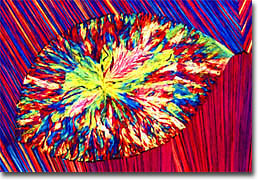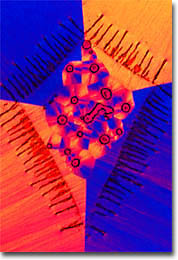|
Although high levels of cholesterol in the body are often associated with health problems, this often-misunderstood substance is actually essential to human life. Indeed, the steroid occurs in almost all animal and human fats as well as in blood, bile, and cell membranes. It is produced primarily by the liver, but may be synthesized by other organs as well and may be introduced to the body in significant quantities through the diet. The important substance, which is white and crystalline in its pure form, is the precursor of vitamin D3 and a number of other types of steroids, such as bile acids and steroid hormones. The formation of the important major steroid hormones from cholesterol occurs through intermediary formation of a steroid known as pregnenolone, which contains the cholesterol nucleus, but has a shorter fatty side chain. Pregnenolone is the precursor of progesterone, the female hormone that dominates during pregnancy, and androgens or male sex hormones, such as testosterone. The estrogen female sex hormones estrone and estradiol and the adrenal corticosteroids, such as corticosterone, are also metabolic products of cholesterol.

Cholesterol
A nonpolar lipid, cholesterol is insoluble in most aqueous solutions, including blood, and must, therefore, be attached to certain protein complexes, called lipoproteins, in order to be carried through the bloodstream. High-density lipoproteins (HDLs) were discovered in 1929 and were later found to frequently transport excess or unused cholesterol from human body tissues back to the liver, where it is broken down into bile acids and excreted. Low-density lipoproteins (LDLs), however, which were discovered in 1950, transport cholesterol from its site of synthesis in the liver to the various tissues and body cells, where it is separated from the lipoprotein for use by the cell. Atherosclerotic deposits, which build up in and narrow the blood vessels, consist primarily of cholesterol attached to LDLs, which has come to be regarded as the "bad" cholesterol. HDLs, on the other hand, may actually serve to retard or reduce this adverse action, and is, therefore, associated with "good" cholesterol. Recent studies suggest that people with low high-density lipoprotein levels may actually be at additional health risk. Due to such findings, it has become a widespread practice to measure and report cholesterol levels in terms of HDL and LDL, rather than as a single number, in an attempt to give a more accurate representation of one's real risk of developing cholesterol-related health problems.

Cholesterol
The term cholesterol was derived from the Greek words chole and stear, which mean "bile" and "hard fat," respectively. The origins of the term are a reflection of the fact that the substance was first identified as a hard, white, solid in gallstones. Though discovered by Poulletier de la Salle in 1769, cholesterol was not named until 1818, when Michel Chevreul rediscovered it and dubbed it cholesterine, believing that the material was likely a fat. A change to the name in 1900, due to the desire to reflect the presence of hydroxyl groups on the molecule, resulted in the term's current form. A significant amount of scientific effort during the twentieth century was dedicated to unraveling the mysteries of this molecule. The structure of cholesterol was known by 1932 and the chief elements of the biosynthetic pathway of it synthesis were explicated in 1956. Much of the research during the latter part of the century concentrated on developing an understanding of how lipoproteins and their receptors play a role in the regulation of cholesterol, and subsequently attempting to develop pharmaceuticals that can effectively lower levels of bad cholesterol in the blood. In fact, the race to discover drugs that will decrease the risk of the hardening of arteries and coronary heart disease continues even today, and many companies are making great strides in the field.

Cholesterol
Even without the aid of cholesterol-controlling drugs, humans have the means of reducing health risks linked with high levels of the steroid simply by making wise decisions in the foods they consume. Since cholesterol is present in animal fat, which occurs in both saturated and polysaturated varieties, but not in fats obtained from plant sources, which are generally unsaturated or polyunsaturated, one way to help reduce consumption of cholesterol is to make a change in the kind of oils and fats one utilizes to cook with. Safflower, soybean, peanut, and other vegetable oils are less likely to contribute bad cholesterol to one's body than lard, butter, and other animal products, and should, therefore, be utilized more often. Moreover, fish oil, though derived from an animal, has been shown by a number of studies to help reduce atherosclerotic deposits by raising HDL, or good cholesterol, levels in the blood. Other dietary changes that may also help reduce the risk of certain health problems include limiting intake of egg yolks, full-fat dairy products, red meat, and liver, and instead favoring lean meats, such as chicken and turkey, fruits, vegetables, and fat-free or reduced fat dairy items. Some evidence also suggests that increasing the amount of soluble fiber in the diet can also affect cholesterol plasma levels in a beneficial manner.
|



